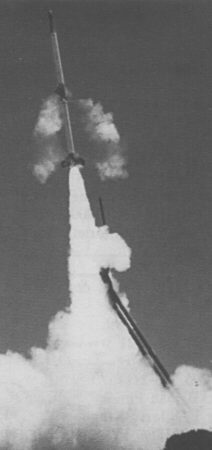
The Spanish works related to the development of a national sounding rocket started in 1967. This year, the Comisión Nacional de Investigación del Espacio (CONIE) charged the Instituto Nacional de Tecnica Aerospacial (INTA) with carrying out a sounding rocket able to send a 15-20 kg payload up to 150 km of altitude.
INTA 255
INTA called upon the British Aerojet Ltd English company to assist it in the project which took the name of INTA-255. This solid propellant rocket was designed from a Goose II main motor (RPE Westcott), accelerated at takeoff by a group of four small Chick boosters, already used by the Skua and Petrel British rockets. All the engines were ignited simultaneously at takeoff, Chick burned 0.2 second and Goose II delivered 22 kN during 17 seconds. The rocket measured 26 cm in diameter and 6.03 m in length (5,08 without the booster rockets) and weighed 340 kg at takeoff. The payload was placed under a fairing of which diameter was slightly lower (23 cm) than the body of the rocket.
All launches were carried out from the El Arenosillo station (Huelva). After a development launch with a reduced power Goose, two nominal INTA-255 were launched successfully in December 1969.

As a matter of fact, the INTA-255 rocket was primarily a test vehicle which was to allow Spain to acquire technologies necessary to build a more powerful sounding rocket able to send 50 kg at around 300 km of altitude. Since 1968, the 1st Plan Nacional del Espacio envisaged the construction of this new rocket, which was finally christened INTA-300 Flamenco.
As previously, the British Aerojet firm was closely associated with the development of the INTA-300. It was, this time, a true two-stage rocket. The Aneto booster rocket developed 138 kN during 3 seconds, whereas the Teide main engine developed 16.3 kN during 16 seconds. Four small spin motors placed at the fins ends of the first stage limited the dispersion. The rocket was 7.27 m long and weighed 503 kg at takeoff.
Two prototypes were launched in 1974 and 1975 with mitigated successes - the apogee being always lower than awaited - before Bristish Aerospace begun carrying out a series of launches of its own version of this vehicle, named Fulmar. During the third INTA-300 launch in 1978, the payload exploded under the fairing, but the last prototype gave entire satisfaction in 1981.
A reduction of the budgets granted to the INTA prevented the continuation of the flights program until the beginning of the 1990s. There then remained three specimens of each motor. Teide and Aneto were test fired to ensure itself of their correct operation after these years of storage. These tests having given satisfaction, the two remaining vehicles were dedicated to photometry experiments (FOCCA) of Instituto de Astrofisica de Andalucia (IAA). Some modifications were necessary to limit the apogee to 150 km and to adapt the 16.5 cm wide payloads initially planned for Nike-Cajun rockets. The vehicles were then named INTA-300B, and carried out two perfectly successful flights in 1993 and 1994.
Tables
a/ INTA rockets evolution
b/ INTA-255 launches
c/ INTA-300 launches
Listings according to Julian Simon, INTA, Spain

Scale in meters
| Type | Mass (kg) | Length (m) | Powder load (kg) | Thrust (kN) | Duration (sec) | Payload (kg) | Apogee (km) |
|---|---|---|---|---|---|---|---|
| INTA-255 | 340 | 6,03 (5,08) | 32,5 + 210 | 20 + 22 | 0,2 + 17 | 25 | 150 |
| INTA-300 | 503 | 7,27 (3.65) | 190 + 135 | 138 + 16 | 3 + 16 | 50 | 300 |
Note : The series includes also the small INTA-100 rocket with axial burning.
| Date | Site | Vehicle | Mission | Results |
|---|---|---|---|---|
| 19 Jul 1969 | ARN | INTA-255 | Technology | S (reduced version) |
| 20 Dec 1969 | ARN | INTA-255#1 | Technology | S (73 km) |
| 22 Dec 1970 | ARN | INTA-255#2 | S (132 km) |
| Date | Site | Vehicle | Mission | Results |
|---|---|---|---|---|
| 09 Oct 1974 | ARN | INTA-300#1 | Technology | SP (250 km) |
| 21 Oct 1975 | ARN | INTA-300#2 | Technology | SP |
| 28 Jun 1978 | ARN | INTA-300#3 | Ba cloud | EF (explosion) |
| 18 Feb 1981 | ARN | INTA-300#4 | Technology | S (285 km) |
| 21 Oct 1993 | ARN | INTA-300B#1 | Photometry | SP (155 km) |
| 16 Apr 1994 | ARN | INTA-300B#2 | Photometry | SP (155 km) |
Notes: All launches from El Arenosillo station, Spain
S: success; PS: partial success; EF: experiment failure